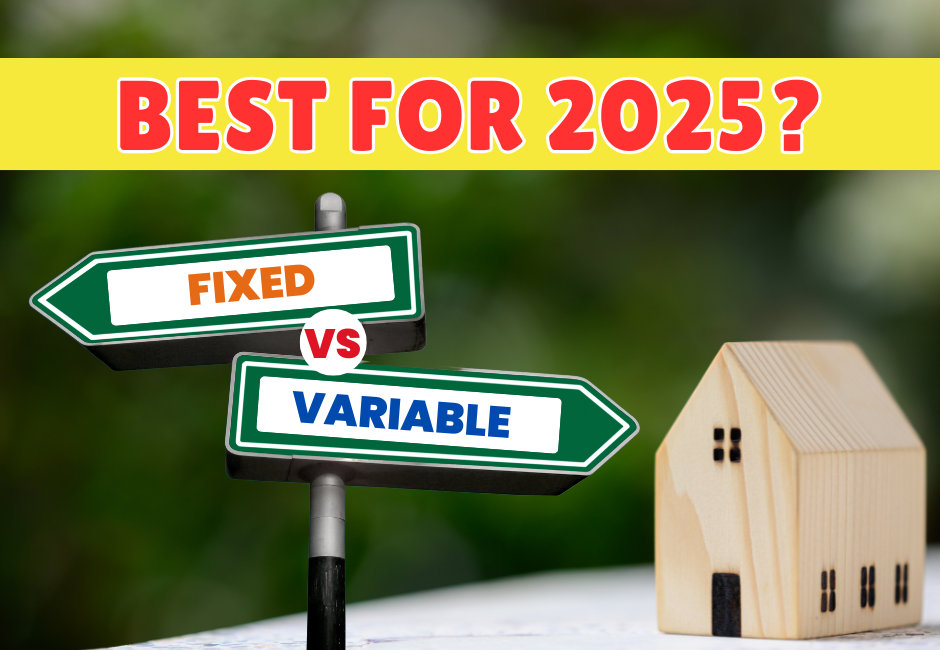
Fixed vs. Variable Home Loans: Which One is Better for Investors in 2025?
Introduction
Choosing between a fixed or variable home loan is one of the most critical decisions property investors face. This choice has a direct impact on borrowing costs, cash flow, and overall investment returns. As 2025 shapes up to be another pivotal year for interest rates, investors need to carefully evaluate their options, factoring in current market conditions, historical patterns, and personal risk tolerance.
Fixed loans offer the comfort of predictable repayments, shielding borrowers from rising rates, while variable loans provide flexibility and potential savings if rates fall. Understanding the performance of each loan type over time, along with expert forecasts, can help investors align their financing strategy with their long-term goals.
This guide provides a data-driven comparison of fixed vs. variable home loans, evaluates the risks and rewards of each based on 2025 market forecasts, shares real-world investor case studies, and offers clear recommendations to help investors make the best decision.
Fixed vs. Variable: A Data-Driven Look at Past Performance
Historical Interest Rate Trends
Interest rate shifts over the past decade have shaped investor strategies and outcomes:
- 2013–2019: The Reserve Bank of Australia (RBA) steadily lowered interest rates, making variable loans appealing as rates declined. Investors on variable rates saw substantial savings.
- 2020–2021: The COVID-19 pandemic drove rates to historic lows, with many investors locking in fixed rates around 2% to secure cheap debt.
- 2022–2023: Surging inflation triggered sharp rate hikes. Variable-rate borrowers faced steep repayment increases, while those who had fixed earlier avoided these shocks.
- 2024: Rates stabilised, with economists beginning to anticipate potential cuts in late 2025 or beyond, shifting some attention back to variable loans.
This cycle highlights why timing and strategy matter when choosing between fixed and variable options.
Fixed vs. Variable Rate Performance Snapshot
| Year | Average Fixed Rate (%) | Average Variable Rate (%) | Rate Change Impact |
| 2015 | 4.50 | 4.85 | Variable rates slightly higher |
| 2018 | 4.00 | 4.20 | Rates mostly stable |
| 2021 | 2.50 | 2.75 | Fixed rates highly attractive |
| 2023 | 6.00 | 6.50 | Variable rates rose sharply |
| 2025 (Forecast) | 5.25 | 5.00 | Potential cuts favoring variable loans |
Repayment example on a $500,000 loan:
- Fixed at 5% → ~$2,684/month
- Variable averaging 5.5% → ~$2,500–$3,000/month (depending on rate shifts)
Choosing the right product can save investors thousands over five years.
Risk and Opportunity: Assessing 2025 Loan Choices
Fixed Loan Pros and Cons
Pros:
- Provides repayment certainty, making it easier to manage cash flow.
- Shields investors from unexpected rate hikes.
- Offers long-term stability, especially useful in high-rate markets.
Cons:
- Generally starts at a higher rate than the lowest variable offers.
- Limited flexibility—break fees apply for early exits.
- Misses out on potential rate cuts if the market softens.
Variable Loan Pros and Cons
Pros:
- Lets investors benefit from falling rates.
- Offers more flexible features, like extra repayments and offset accounts.
- Easier to refinance or switch lenders if needed.
Cons:
- Repayment amounts fluctuate, making budgeting more challenging.
- Rising rates can quickly increase borrowing costs.
- Adds risk in volatile rate environments.
Expert Forecasts for 2025
- Most likely scenario: Gradual rate cuts, especially in late 2025, if inflation cools.
- Alternative scenario: Rates remain steady if inflation proves stubborn.
- Less likely but possible: Further rate hikes if new global shocks or supply disruptions emerge.
This outlook suggests variable loans may appeal to investors willing to bet on rate declines, while fixed rates remain attractive for those prioritising certainty.
Real-World Investor Case Studies
Case Study 1: Fixed Loan for Stability
Investor: Emma, owner of three rental properties
Strategy: Fixed all loans at 2.5% in 2021 for five years
Outcome: Protected against 2022–2023 rate hikes; properties remained cash-flow positive. If rates fall in 2025, Emma may pay above-market rates until her fixed term ends.
Case Study 2: Variable Loan for Flexibility
Investor: Tom, first-time investor
Strategy: Took a variable loan in 2024, anticipating a peak in rates followed by cuts
Outcome: Managed repayment fluctuations carefully. If rates drop in late 2025, Tom stands to benefit with lower repayments.
Case Study 3: Split Loan for Balanced Risk
Investors: Michael and Sarah, investing couple
Strategy: Split loan—half fixed at 5%, half variable
Outcome: Balanced stability with exposure to potential rate cuts. This mixed approach worked well in uncertain conditions.
Recommendations for 2025
Who Should Consider a Fixed Loan?
- Investors focused on repayment stability.
- Borrowers with tight cash flow or multiple properties needing predictable costs.
- Those expecting rates to stay high for longer.
Who Should Consider a Variable Loan?
- Investors betting on rate cuts in the next 12–24 months.
- Borrowers who want flexibility to make extra repayments or refinance.
- Those with a strong cash buffer to handle rate fluctuations.
Who Should Consider a Split Loan?
- Investors looking for a mix of certainty and flexibility.
- Borrowers uncertain about rate direction but wanting to hedge their bets.
- Those seeking a balanced approach to managing risk.
Final Thoughts: Align Loan Choice With Your Investment Strategy
Whether fixed or variable, the best home loan in 2025 will depend on your investment goals, cash flow needs, and market outlook. History suggests fixed rates shine during rising-rate cycles, while variable loans perform better when rates fall. With expert forecasts hinting at possible rate cuts, variable loans could become increasingly attractive. However, for risk-averse investors, fixed rates still offer valuable peace of mind.
For many, a split loan may deliver the best of both worlds—blending repayment security with flexibility.
By combining market analysis, careful assessment of your financial position, and smart use of loan comparison tools, you can confidently choose a mortgage that strengthens your investment portfolio and positions you for success in 2025 and beyond.




